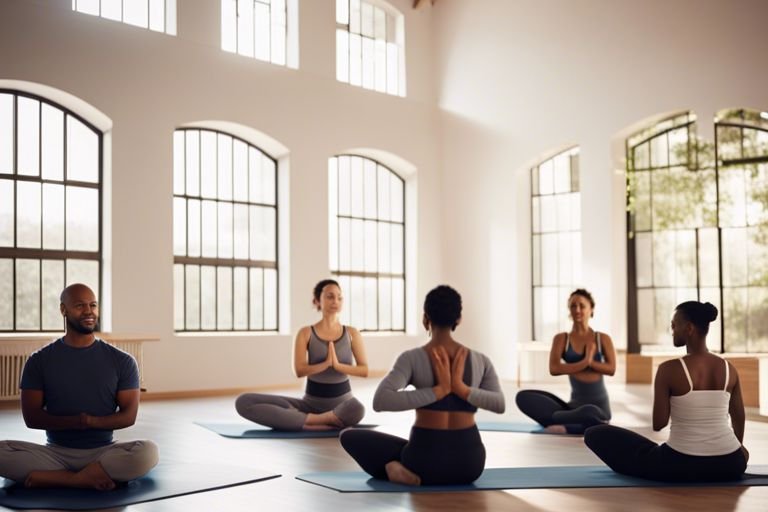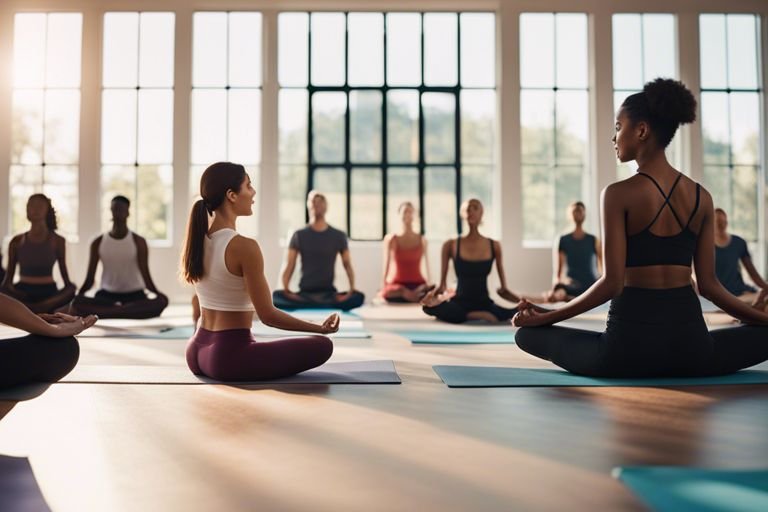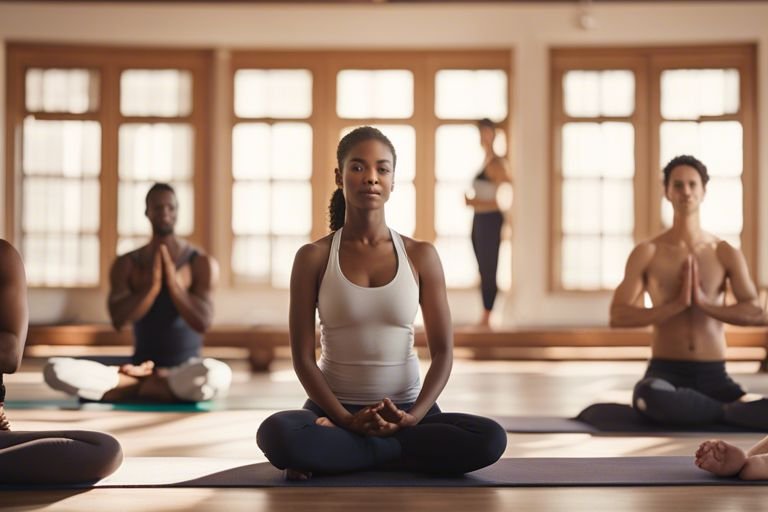As you launch on your yoga journey, you’re likely eager to experience the numerous benefits that this ancient practice has to offer. Perhaps you’re looking to improve your flexibility, reduce stress, or simply cultivate a deeper connection with your body. Whatever your goals may be, starting a yoga practice can seem daunting, especially if you’re new to it. Fear not! With these easy and effective yoga routines, you’ll be able to gently ease into the world of yoga, building a strong foundation and setting yourself up for a lifelong journey of wellness and self-discovery.

Key Takeaways:
- Foundational Poses: The book focuses on teaching beginners the vital yoga poses that build a strong foundation for their practice. These poses improve flexibility, balance, and strength, and are modified to accommodate different fitness levels.
- Customizable Routines: The book provides a variety of yoga routines that can be tailored to individual needs and goals. Whether you’re looking to reduce stress, improve sleep, or increase energy, the book offers routines that can be adapted to suit your lifestyle.
- Safe and Accessible: The author emphasizes the importance of listening to your body and honoring its limitations. The book includes tips and modifications to ensure a safe and accessible practice, making yoga accessible to everyone, regardless of age, size, or ability.

Preparing for Yoga
A successful yoga practice begins with preparation. Before you start practicing yoga, it’s vital to create an environment that fosters focus, comfort, and relaxation. In this chapter, we’ll guide you through the necessary steps to prepare yourself for a rewarding yoga experience.
Creating a Conducive Environment
Anywhere you choose to practice yoga, make sure it’s quiet, calm, and free from distractions. Consider investing in a good quality yoga mat, and if possible, practice near a window to allow natural light to flow in. A peaceful environment will help you focus on your breath and movements, allowing you to get the most out of your practice.
Choosing the Right Equipment
Essentially, all you need to start practicing yoga is your body and a willingness to learn. However, having the right equipment can enhance your practice and provide support when needed.
To get started, you’ll need a good quality yoga mat that provides grip and cushioning. You may also want to consider investing in a few props such as blocks, straps, and blankets to help you modify poses and maintain proper alignment. These props can be especially helpful if you’re new to yoga or have any physical limitations. Bear in mind, the goal of yoga is not to compete with others, but to listen to your body and honor its limitations.
Basic Yoga Poses for Beginners
While you’re new to yoga, it’s vital to start with basic poses that will help you build a strong foundation and prepare your body for more advanced practices. If you’re unsure where to begin, don’t worry! According to New to yoga? Start with these 10 poses for beginners, mastering these fundamental poses will set you up for success.
Mountain Pose (Tadasana)
With your feet hip-width apart and arms by your sides, Mountain Pose is the foundation of all standing poses. Engage your core, lengthen your spine, and feel grounded and stable. This pose helps establish good posture and balance.
Downward-Facing Dog (Adho Mukha Svanasana)
On all fours, walk your hands forward, and lift your hips up and back, straightening your arms and legs. Keep your palms and heels grounded, and engage your core. This pose stretches your hamstrings, calves, and spine.
Poses like Downward-Facing Dog help increase flexibility and strength, preparing your body for more complex poses. As you practice, focus on keeping your body in a straight line from head to heels.
Cobra Pose (Bhujangasana)
To enter Cobra Pose, lie on your stomach with your hands under your shoulders. Inhale, press your palms into the ground, and lift your chest and head off the mat. Keep your shoulders down and away from your ears.
It’s vital to engage your back muscles and maintain a gentle, relaxed neck in Cobra Pose. This pose strengthens your back and opens your chest, improving your overall posture.
Child’s Pose (Balasana)
Pose yourself on your knees, then sit back onto your heels. Stretch your arms out in front of you, lower your forehead to the ground, and breathe deeply. This pose is a gentle stretch for your back and hips.
Basic yoga poses like Child’s Pose provide a safe space to rest and recharge. Use this pose to relax and refocus whenever you need a break during your practice.
Tree Pose (Vrksasana)
Tadasana, the Mountain Pose, is the foundation of Tree Pose. Shift your weight onto one leg, keeping the other foot resting on the inner thigh. Engage your core, lift your arms, and gaze forward.
Tree Pose helps improve your balance and stability, strengthening your ankles and calves. As you practice, focus on maintaining a steady, grounded energy.
Simple Yoga Routines for Beginners
Now that you’ve started your yoga journey, it’s time to explore some simple yet effective routines that will help you establish a consistent practice.
Morning Stretch Routine
To begin your day feeling refreshed and energized, try this gentle morning stretch routine. Start with some light neck stretches, followed by shoulder rolls and chest opens. Move on to some gentle twists and hip openers, finishing with some deep breathing exercises to center yourself for the day ahead.
Evening Relaxation Routine
With the stresses of the day behind you, unwind with this calming evening relaxation routine. Begin with some gentle forward bends, followed by seated twists and hip flexor stretches. End with some restorative poses, such as legs up the wall or reclined pigeon, to quiet your mind and soothe your body.
This routine is designed to calm your nervous system, helping you to relax and prepare for a restful night’s sleep. As you move through the poses, focus on releasing any tension or stress, allowing yourself to let go and surrender to the present moment.
Quick Desk Break Routine
Simple stretches can make a big difference in your overall well-being, especially when done regularly. Take a few minutes to stretch at your desk with this quick routine. Start with some wrist extensions and finger spreads, followed by shoulder rolls and neck stretches. Finish with some ankle rotations and toe taps to get your blood flowing.
Evening out your workday with regular breaks can help increase productivity and reduce eye strain. Try to take a few minutes every hour to stand up, stretch, and move your body – your mind and body will thank you!
Tips for a Successful Yoga Practice
Your yoga practice is a journey, and it’s vital to approach it with patience, kindness, and awareness. To ensure a successful practice, follow these tips:
- Start slow and gentle, gradually increasing intensity and duration as you become more comfortable.
- Practice regularly, ideally at the same time every day, to establish a consistent routine.
- Invest in a good quality yoga mat and comfortable clothing that allows for a full range of motion.
- Find a quiet, peaceful space to practice, free from distractions and interruptions.
After incorporating these tips into your practice, you’ll be well on your way to experiencing the many benefits of yoga.
Listening to Your Body
To honor your body’s unique needs and limitations, pay attention to its signals, and modify or rest when necessary. This mindful approach will help prevent injuries and foster a deeper connection with your inner self.
Breathing Techniques
Successful breathing techniques are vital to a balanced yoga practice. Focus on deep, controlled breaths, inhaling through your nose and exhaling through your mouth, to calm your mind and energize your body.
Body awareness is closely linked to breathing techniques. As you inhale, feel your chest expand and your spine lengthen; as you exhale, feel your body relax and release tension. This harmonious connection will enhance your overall yoga experience.
Staying Motivated
Successful yoga practitioners understand the importance of consistent practice. To stay motivated, set achievable goals, celebrate small victories, and remind yourself of the benefits you’re experiencing, from increased flexibility to reduced stress.
Breathing new life into your practice, try exploring different yoga styles, attending workshops, or practicing with a friend to keep things fresh and exciting. This will help you stay engaged and committed to your yoga journey.
Conclusion
Conclusively, as you initiate on your yoga journey, remember that the key to progress lies in consistency, patience, and self-awareness. You now possess the tools to craft a personalized practice that honors your unique needs and goals. By incorporating these easy and effective yoga routines into your daily routine, you will begin to experience the transformative power of yoga, cultivating strength, flexibility, and serenity in body, mind, and spirit. May your practice be a lifelong journey of discovery and growth.
FAQ
Q: What are the benefits of starting a yoga practice as a beginner?
A: Starting a yoga practice as a beginner can bring numerous benefits to both physical and mental health. Yoga can help increase flexibility, balance, and strength, while also reducing stress and anxiety. It can also improve sleep quality, boost mood, and enhance overall well-being. Additionally, yoga can increase self-awareness, concentration, and focus, leading to a greater sense of calm and clarity in daily life. With regular practice, beginners can experience these benefits and more, making yoga an excellent addition to a healthy lifestyle.
Q: What are some necessary items I need to get started with yoga?
A: To get started with yoga, you’ll need a few necessary items. First, invest in a good-quality yoga mat that provides grip and cushioning. You may also want to consider purchasing a set of yoga blocks, straps, and blankets to help with alignment and flexibility. Comfortable, stretchy clothing is a must, and it’s recommended to avoid anything too loose or baggy. Finally, find a quiet, peaceful space to practice, free from distractions, where you can focus on your breath and movements. Optional items include a yoga bolster or pillow for support and a yoga app or DVD to guide your practice.
Q: How often should I practice yoga as a beginner, and what’s the best way to create a routine?
A: As a beginner, it’s recommended to start with 2-3 times per week, with at least one day of rest in between. This allows your body to adjust to the new movements and prevents injury or burnout. Begin with shorter practices, around 20-30 minutes, and gradually increase the duration as you become more comfortable. To create a routine, start by setting a specific time and day for your practice, and try to stick to it. You can also create a schedule or planner to track your progress and stay motivated. Additionally, consider finding a yoga buddy or joining a yoga class to help keep you accountable and inspired.
